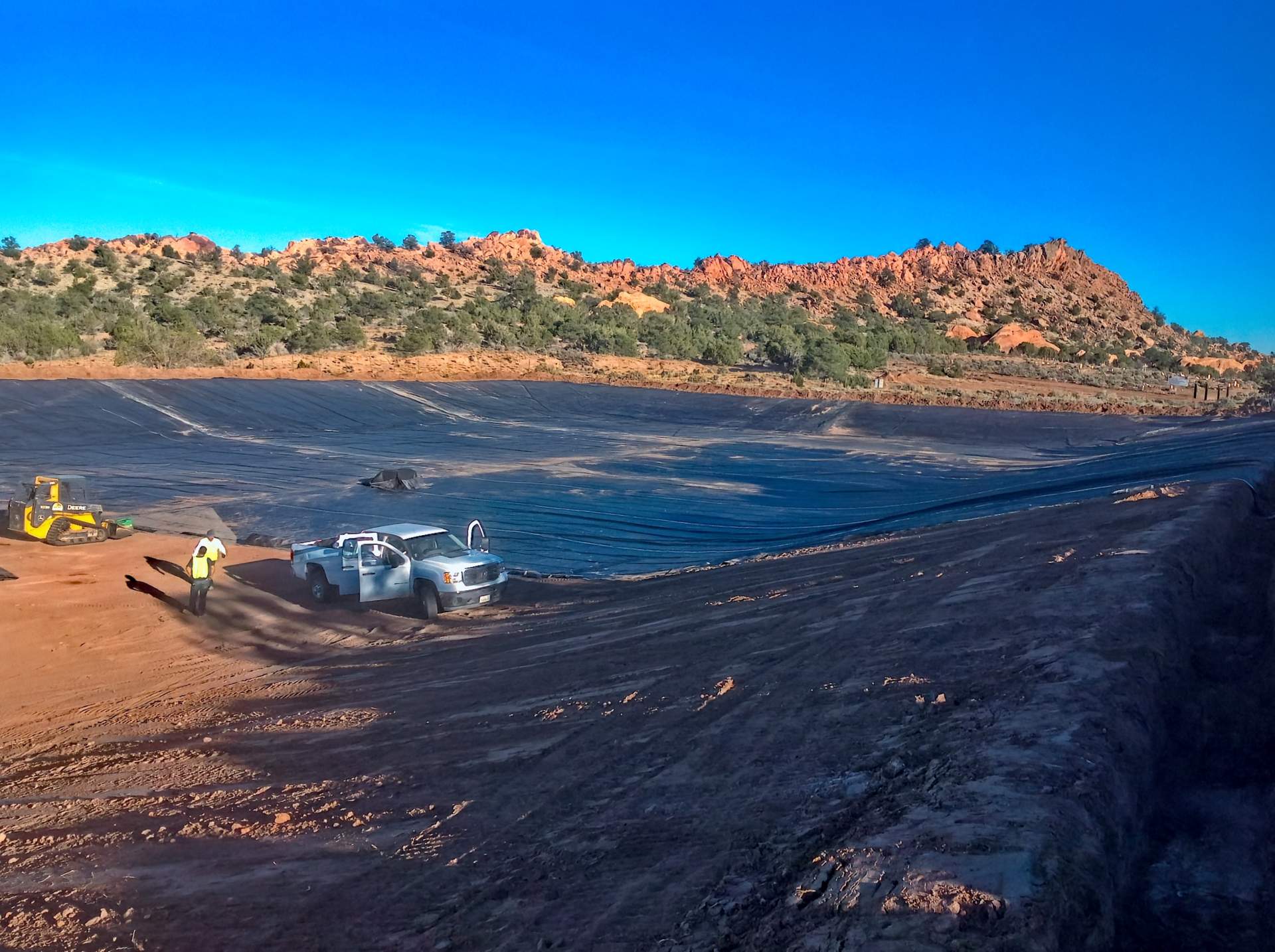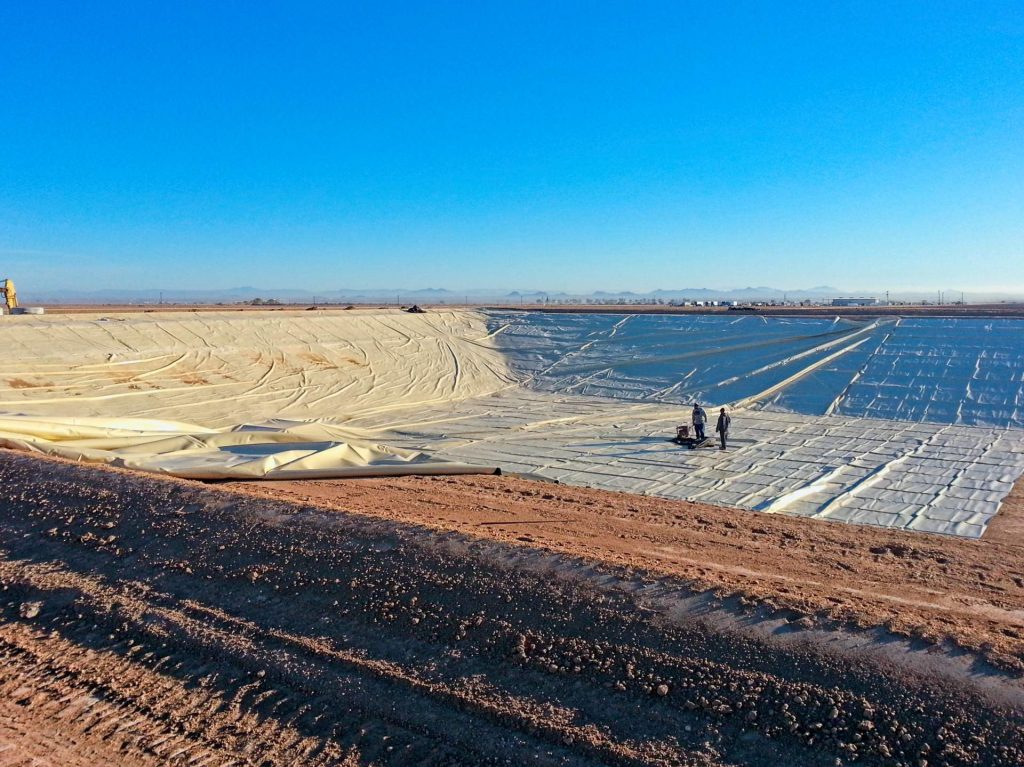High-Performance Pond Liner Material for Large Projects
Choosing the best pond liner material can often be confusing for many customers with so many options available today. Western Environmental Liner offers expert guidance to help you choose the right pond lining material based on containment goals, site conditions, and service life.


Fortunately, due to Western Environmental Liner’s extensive 30 year history with various pond liner materials, we are able to select the best pond liner material for each particular application which enables us to provide the best value to our customers.
Not all reinforced liners are equal—our engineered pond lining material resists UV damage, root intrusion, and hydrostatic pressure. We fabricate each pond lining to spec, reducing waste and simplifying installation on irregular terrain.
Western Environmental Liner prides itself on never selling a pond liner product that is overkill for an application or selecting a pond material that won’t get the job done right. Be assured that we have your best interest at heart.
Due to its affordability, in most cases we recommend a reinforced pond liner product for most pond liner applications. These type of pond liners are often lighter, stronger, much more tear resistant, & less expensive than unreinforced pond liners. One thing to note is that thickness does not always equate to quality. An unreinforced pond liner product often needs to be much thicker than a reinforced pond liner to work well. When this extra thickness is factored into the price, an unreinforced pond liner is often more expensive overall. Not every situation is the same though, for instance, when a large pond liner needs to conform perfectly to every nook and cranny of a pond, a highly flexible and malleable film such as pvc may be the best option. Large preformed pond liners often produce the best results.
For water ponds, the biggest consideration should be if the pond liner will be exposed to the sun or not. Sun exposure to a pond liner is often a necessary evil. Often with large ponds a steep slope is being used which can make covering the pond liner with dirt difficult due to the dirt falling down into the pond and leaving the liner exposed to the sun.
When sun exposure is unavoidable, Western Environmental Liner recommends UV-stabilized pond lining material that retains flexibility under extreme heat. This helps prevent shrinkage, cracking, and brittleness common in lower-grade liners.
Reinforced Polyethylene (RPE) is often the best value liner material for most applications. It is very strong both in tear resistance and puncture resistance and is often stronger than products three times as thick and heavy. RPE comes in a variety of thicknesses from 12 mil up to 60 mils thick. RPE also has ranges of u.v resistance usually correlating with its thickness with some of the thicker RPE’s lasting well over 20 years in the sun. Please contact Western Environmental Liner for more details on what RPE liner that is right for you.
Reinforced Polypropylene is usually the best pond liner choice for exposed applications. Our 45 mil Reinforced Polypropylene will last over 20 years when exposed for water applications and also works well with many other fluids. Although more expensive than Reinforced Polyethylene, there is no need to worry about the sun’s rays destroying the liner for a very long time.
Although we do have our preferences which most often has to do with best value for the customer, we know sometimes other products are specified into a project and we can usually provide those materials as well. We provide liners that are also resistant to oils, chemicals, and waste, but these liner options are not normally described as a pond liner.
Due to the fact that Western Environmental Liner is one of the leading manufacturers of pond liners in the world, this enables us to offer large discounts and in many cases, warranty guarantees backed by our 30-year experience in the pond liner industry. Our dedicated staff of pond liner professionals are ready to answer your questions to help ensure you choose the right pond liner for your application. Pond liners can offer an unlimited potential for design, long lasting capacity, and low maintenance cost. An investment in a high quality pond liner will enable you to have a long lasting containment solution.
Western Environmental Liner serves golf courses, municipalities, and agricultural operations with custom pond lining built for challenging water retention needs. Every panel is quality-inspected for thickness, seams, and resistance to environmental stress. Our pond lining material meets ASTM and NSF standards, making it suitable for potable water and eco-sensitive containment projects. We also provide spec sheets and layout drawings to support engineers and contractors designing long-term pond lining systems.

1. Do I need underlayment for a pond liner?
Yes. A geotextile underlayment protects your liner from punctures caused by sharp rocks or roots under the weight of a filled pond. While the liner ensures impermeability, the underlayment prevents hidden hazards from causing damage. See our guide to Geotextile Underlayment.
2. How much should a pond liner overlap?
For large ponds, plan on at least 5 feet of overlap around all edges to secure the liner in a trench. Larger projects may require more, while smaller ponds may need less. Use our online pond liner calculator to estimate liner size, and review our Large Pond Liner Installation Guide for complete instructions.
3. Can you join a pond liner?
Yes, but field welding is a specialized task and one of the leading causes of liner failure. Factory welding under controlled conditions ensures the strongest, most reliable seams. For best results, order a custom liner manufactured to your specifications. See our guide to Installation Tips and Pitfalls with Pond Liners for details.
4. What is the best liner for a pond?
Ponds vary in size and usage, but in general for large ponds, including fish ponds, Reinforced Polyethylene (RPE) offers the best balance of cost, durability, and performance. For smaller ponds or situations requiring high UV resistance, Reinforced Polypropylene (RPP) is recommended. While materials like EDPM rubber are widely available through retailers, better results usually come from RPE, PVC and HDPE - and see why RPE can be better than HDPE for pond liners.
5. How long does a pond liner last?
Quality pond liners should last at least 20 years. Always work with a trusted manufacturer and installer who can back their products with a 20-year warranty. This ensures peace of mind and protection for your investment.
Please contact us via either e-mail or phone to help you choose the best value pond liner for your application.

